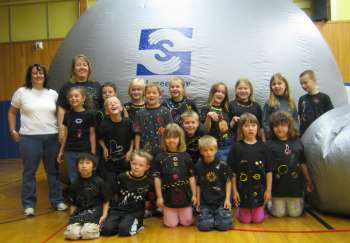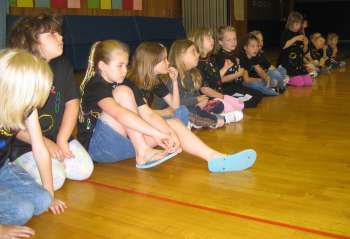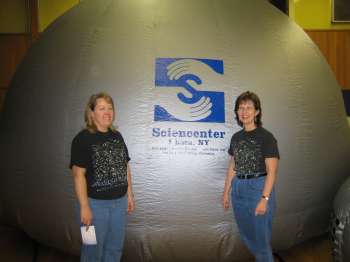- By Dan Veaner
- Entertainment
 Print
Print
Second graders were star struck last week when they completed a unit about space by visiting a planetarium in the Lansing Elementary School gymnasium. "We rent it from the Sciencenter," says teacher Hallie Snow. "We have it for two days. Each second grade class comes for 45 minutes the first day, then again on the second day. They all make T-shirts on the second day, which they wear to the second star show."

Snow is one of two Lansing teachers who are trained to use the planetarium. It is an igloo-shaped plastic structure with an entryway students crawl through to get inside. A cube inside holds a projector and a selection of cylinders with different views of the sky, including some with the lines drawn in so kids can see the constellations. A fan keeps the structure inflated. "The kids like it," says Snow. "It's fun. They can tell you about the constellations and the stories behind them. They're excited."
Second grade teacher Marilyn Farmer assisted Snow with the presentation this year. "The kids love this unit," she says. "They're so motivated to learn all about space, and they're risk takers. So they can see themselves in space and being an astronaut, and living aboard the shuttle. Of course they think they're going to fly to Pluto in two minutes. It's fun to watch them."

On Friday Snow put a cylinder onto the lamp assembly, then dialed in longitude and latitude to display the stars she wanted. The first cylinder showed constellations as Native Americans saw them, a review from Thursday's visit. The children loved the drawings of creatures like an eagle, wolverine, the big dog as Snow pointed out the stars that made them up using a red light pointer. The next cylinder showed the more familiar constellations named for characters in classical mythology, including Orion, Canus Major, Taurus the Bull, Cassiopeia, and Ursa Major (which contains the Big Dipper and the Lansing Star which were pointed out to the kids, who had earlier received cards telling how to locate the town's star).
As Snow rotated the stars Farmer played music. Many of the kids called out the names of constellations they were studying. "I like how they have lines to show you the stars," said student Alec Barden. Morgan Downing said, "I learned that there are 88 constellations. I thought there were less than 88." "I like it when you can see the moon come up," Jacob Lange added.

Second Grade Teachers Hallie Snow (left) and Marilyn Farmer
"This is the culminating activity to our space theme that we do in second grade," Snow explains. "We do a four to six week theme on everything from living in space to astronomy and constellations, to planets and the solar system, the moon, the International Space Station. We tie into Cornell's Planetary Imaging Facility. We go there for our end-of-year field trip, and do the Carl Sagan planet walk."
The second graders were excited by the presentation, recognizing constellations and watching the stars move across the night sky. They all wore T-shirts they had decorated in a star theme. Kailee Rooker liked the Lansing Star, saying, "I think the town star is really cool." Tia Soprano added, "At the beginning of the school year I thought there wasn't anything such as constellations." That may have been so, but now all the second graders are experts on the stars and space.
----
v2i19

Second grade teacher Marilyn Farmer assisted Snow with the presentation this year. "The kids love this unit," she says. "They're so motivated to learn all about space, and they're risk takers. So they can see themselves in space and being an astronaut, and living aboard the shuttle. Of course they think they're going to fly to Pluto in two minutes. It's fun to watch them."

On Friday Snow put a cylinder onto the lamp assembly, then dialed in longitude and latitude to display the stars she wanted. The first cylinder showed constellations as Native Americans saw them, a review from Thursday's visit. The children loved the drawings of creatures like an eagle, wolverine, the big dog as Snow pointed out the stars that made them up using a red light pointer. The next cylinder showed the more familiar constellations named for characters in classical mythology, including Orion, Canus Major, Taurus the Bull, Cassiopeia, and Ursa Major (which contains the Big Dipper and the Lansing Star which were pointed out to the kids, who had earlier received cards telling how to locate the town's star).
As Snow rotated the stars Farmer played music. Many of the kids called out the names of constellations they were studying. "I like how they have lines to show you the stars," said student Alec Barden. Morgan Downing said, "I learned that there are 88 constellations. I thought there were less than 88." "I like it when you can see the moon come up," Jacob Lange added.

Second Grade Teachers Hallie Snow (left) and Marilyn Farmer
"This is the culminating activity to our space theme that we do in second grade," Snow explains. "We do a four to six week theme on everything from living in space to astronomy and constellations, to planets and the solar system, the moon, the International Space Station. We tie into Cornell's Planetary Imaging Facility. We go there for our end-of-year field trip, and do the Carl Sagan planet walk."
The second graders were excited by the presentation, recognizing constellations and watching the stars move across the night sky. They all wore T-shirts they had decorated in a star theme. Kailee Rooker liked the Lansing Star, saying, "I think the town star is really cool." Tia Soprano added, "At the beginning of the school year I thought there wasn't anything such as constellations." That may have been so, but now all the second graders are experts on the stars and space.
----
v2i19
